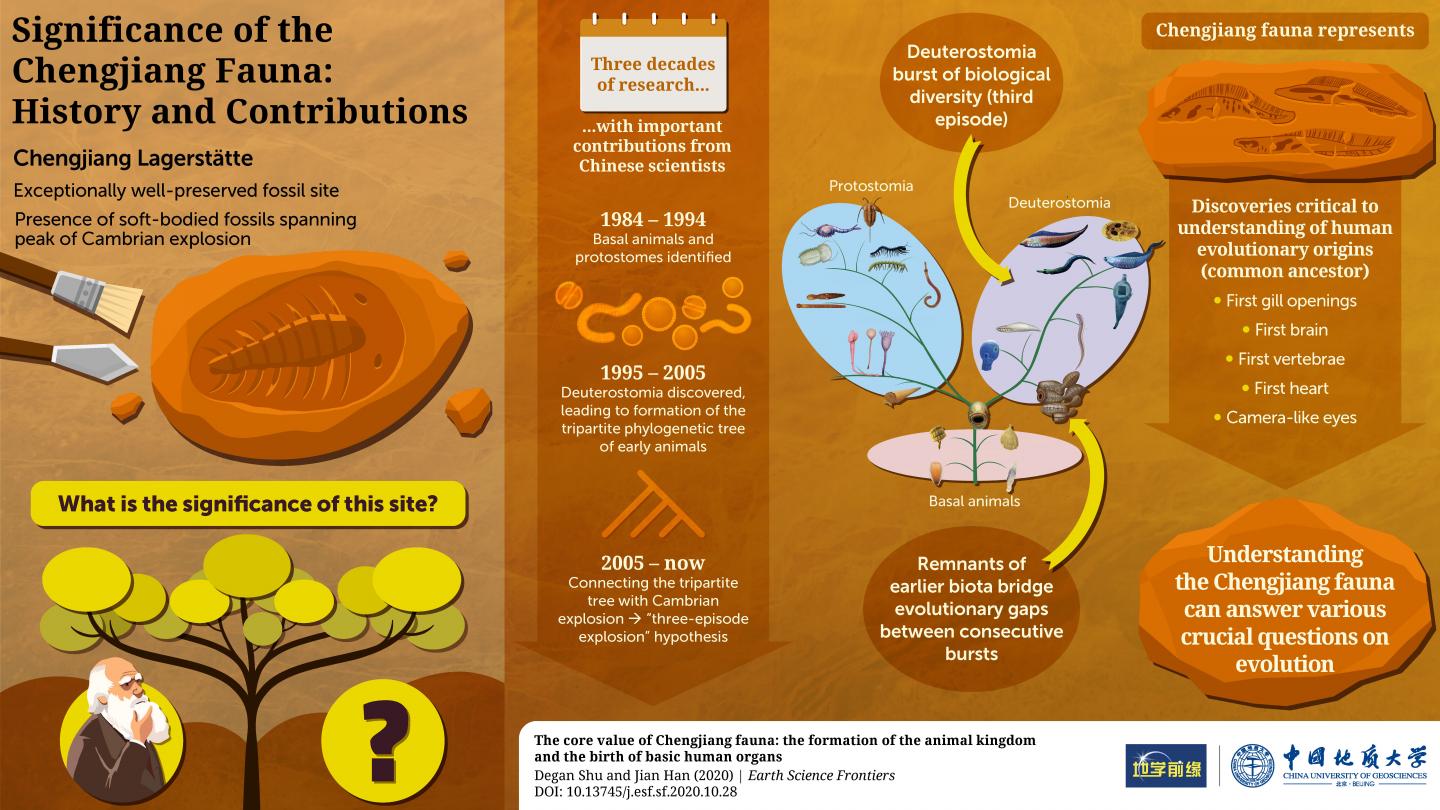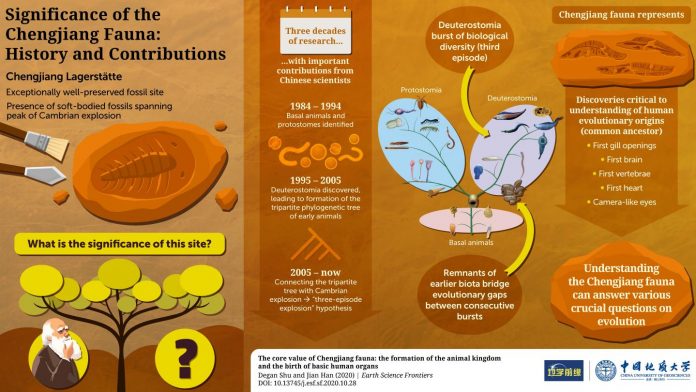
Photo: Dr Degan Shu from Northwest University and his team discuss their findings and highlight the scientific and philosophical significance of the diverse fossil site Chengjiang lagerstatte in Yunnan Province, China.
view more
Credit Image: Earth Science Frontiers
Much of what we know regarding how life–as we know it–came into existence is through the recovery of fossils from various sites in the word. The Chengjiang lagerstatte in Yunnan Province, China, is one such unique site containing very well-preserved fossils (also called the “Chengjiang fauna”), which include soft-bodied animals that normally do not get fossilized. Most of these fossils are 520 to 518 million years old, spanning a part of the Cambrian period when life on earth exploded in diversity, leading to a huge increase in number of species–a phenomenon called the “Cambrian explosion.” In a new study, two scientists who spent many years digging deeper into this field, including Dr Degan Shu from Northwest University in Xi’an and Dr Jian Han from Northwest University in Shaanxi Xi’an, present an overview of their research on the Chengjiang fauna and emphasize its significance. These findings, which are published in Earth Science Frontiers, include significant contributions from Chinese paleontologists, including Prof Shu’s group, in collaboration with other international scientists.
The research spanned three decades, each decade bringing important developments. The first decade (1984-1994) led to important findings on basal animals (e.g., sponges and jellyfish) and the subkingdom Protostomia (e.g., molluscs). In the second decade (1995-2005), scientists including Shu’s team continued to discover newer animal groups, the most significant being deuterostomes (a large group of animals, which includes humans). In the third stage (2005-now), the Chinese teams continued to add new groups to the animal tree and dug deeper into the relationships between the formation of the tree and the multi-episodic Cambrian explosion. This paved the way for not only the formulation of a three-part phylogenetic tree of early animals but also the hypothesis that the Cambrian explosion occurred in three episodes–the evolution and diversification of basal animals, followed by protostomes, and finally deuterostomes–forming the basis of all forms of animal life today.
On the importance of the Chengjiang fauna, Dr Shu comments, “Today, many people still believe in creationism, and a common argument that they use is an incomplete fossil record. We feel that filling the gaps in the evolutionary tree with transitional forms, such as those found at Chengjiang and other sites, will help us to gradually dispel misinformation about the theory of evolution, especially when we consider the question of how humans came to be. In essence, we can trace the origins of all extant animals, including us, to ancestors in the Cambrian.”
In particular, Dr Shu points to the discovery of seminal fossils that demonstrate the early forms of our basic organs evolved during the Cambrian explosion. These include the mouth, brain, heart, and vertebrae. It is through comparisons of Chengjiang fossils from the Cambrian period with those from the Precambrian (before Cambrian) period that researchers realized that Precambrian life did not have these basic organs. This reveals the importance of Chengjiang as a reservoir of fossilized soft body parts, such as the nervous system. In fact, some specimens have such well-preserved nervous systems that scientists could use them to infer how certain species behaved, working from the idea that a complex nervous system implies complex behaviors. This incredible insight offered to us by the Chengjiang lagerstatte provides direct evidence explaining the gradual evolution in the animal kingdom. Dr Shu concludes, “As a compelling testimony of Darwinian theory, the Chengjiang fossils have profound scientific and humanistic significance. Our hope is that the fascinating discoveries at this site will help improve scientific literacy in the public, while also providing new generations of scientists with a framework that they can use to flesh out the animal tree of life.”
The Chengjiang fauna, indeed, holds immense significance–both scientific and philosophical. And the extensive efforts by scientists like Dr Shu bring us closer to understanding the most fundamental question today: where lies the origin of life?
###
Reference
Authors: Degan Shu and Jian Han
Title of original paper: The core value of Chengjiang fauna: the formation of the animal kingdom and the birth of basic human organs
Journal: Earth Science Frontiers
DOI: 10.13745/j.esf.sf.2020.10.28
Affiliations: Shaanxi Key Laboratory of Early Life and Environments (SKLELE), State Key Laboratory of Continental Dynamics, Department of Geology, Northwest University, Xi’an 710069, China Northwest University Museum, Shaanxi Xi’an 710069, China
About Earth Science Frontiers
Earth Science Frontiers is a bimonthly peer reviewed scholarly journal co-sponsored by the China University of Geosciences (Beijing) and Peking University. It was first published in 1994, and academician Wang Chengshan is the current Editor-in-Chief. Each issue of the journal is centered on a specific geoscience topic and managed by experts in that field as Guest Editors. Each issue also contains a number of articles on self-select subjects. Articles published in Earth Science Frontiers cover all disciplines of earth sciences with emphasis on frontier and innovative basic research. At the same time, the journal also publishes research findings that may be considered contentious. Over the years, Earth Science Frontiers has won several publisher awards, including “The Internationally Most Influential Journal in Chinese Language” and “The Top 100 Outstanding Chinese Scholarly Journals.” In 2019, Earth Science Frontiers was selected among top-tier journals to join a national action plan for achieving excellence in science and technology research publishing in China.
E-mail: frontier@cugb.edu.cn
Website: http://www.
About Dr Degan Shu
Dr Degan Shu is an eminent paleontologist and academician currently working at Northwest University in Xi’an, China, as part of the Shaanxi Key Laboratory of Early Life and Environments. He received his undergraduate training in Paleontology at Peking (Beijing) University from 1964 to 1969, obtaining his master’s degree at Northwest University (Xi’an) and PhD in China University of Geosciences (Beijing). He was a Visiting Scholar at the Smithsonian Institution, Washington, D.C., in 1988, a Humboldt Research Fellow at both University of Bonn in 1988-1989 and University of Wuerzburg, Germany, in 1994-1995, as well as a visiting scholar at Cambridge University, UK, in 1998. Dr Shu has authored over 100 papers on the Cambrian Explosion in his long career of over 25 years. Dr Shu has also translated Darwin’s Origins of Species into Chinese.
TDnews (tunisiesoir.com)















